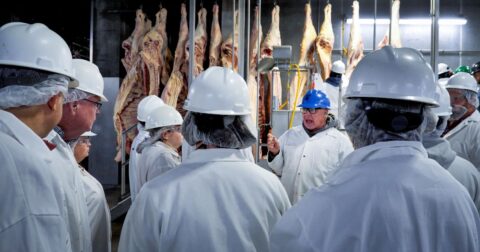Solutions
How Milwaukee Activists Used Community Organizing to Prevent Slaughterhouse Construction
Food•5 min read
Perspective
We need to talk about the humans most affected by factory farming.

Perspective • Food • Workers

Words by Valerie Monckton
Slaughterhouse workers experience depression levels four times higher than the national average. This, according to a 2021 review paper published in the journal Trauma, Violence & Abuse, also accompanies an increased likelihood of anxiety, psychoticism, anger, hostility and somatization (physical illnesses often associated with stress, with no known direct cause). The mental and physical health issues suffered by slaughterhouse workers garnered attention during the first year of the Covid pandemic, as packed abattoirs became hotbeds for the virus, and many vulnerable workers died. But as concern around the virus waned, so too did consideration for those workers who kill for a living. And yet, the problem persists, affecting not only those who work in slaughterhouses, but also their communities.
Within the Canadian province of Alberta — the top beef producing province in the country — lies Brooks, a small town characterized by the smell of slaughter. While the stench of death permeates much of the area, the slaughterhouse (now owned by meat giant JBS) is nowhere to be seen. It is kept tucked away, just off the Trans-Canada Highway, three miles away from Brooks itself.
This is by design, a tactic used for centuries. Hiding away the dirty work no one else wants to see and polluting the environments of mostly rural and low-income residents.
The first buildings dedicated solely to slaughter — differing from backyards, butcher shops and meat markets — became more common in the 1800’s, in-part out of a desire to hide work deemed “morally dangerous.”
According to the paper, A Social History of the Slaughterhouse: From Inception to Contemporary Implications, “a heated battle over slaughterhouse reform” emerged in London at that time, as some members of the public were concerned that witnessing and inflicting violence against animals would lead people to behave violently. As a result, slaughter was moved from more public spaces to windowless buildings out of town.
And there it remains.
Hiding the work of killing animals doesn’t eliminate the violence or prevent its spillover. In 1996, Brooks’s slaughterhouse expanded its operations, and during the five years or so that followed, the town saw a 15 percent boom in the population. During that same period, it also saw a 70 percent increase in crime rates.
This isn’t an anomaly, according to research looking at the correlation between slaughterhouse work and crime. In 2009, a study examined the crime rates of communities with slaughterhouses compared to those with other manufacturing industries with similarly “high immigrant worker concentrations, low pay, routinized labor, and dangerous conditions,” (such as industrial laundering, iron and steel forging, etc.). The researchers found that the number of slaughterhouse employees in a community is a significant predictor for total arrests, violent arrests, rape and other sex offenses.
Amy Fitzgerald, PhD, one of the study’s authors and a professor of sociology and criminology at the University of Windsor, explains to Sentient that the relationship between slaughterhouses and crime is unique. She says that in her analysis, non-slaughterhouse industries didn’t see the same increase in crime. “There were a couple instances where they were related to some types of crime, but it was actually an inverse relationship. So, more employment in that [other] industry was associated with a reduction in crime.”
A further study evaluating slaughterhouse workers’ aggression found that slaughterhouse workers’ overall propensity-for-aggression and physical aggression scores are high, and are similar to incarcerated populations. This makes sense, since both populations often exist in violent environments and are frequently victims of trauma.
Slaughterhouse staff exist within a society that devalues their work, a society that “doesn’t want to think about it, doesn’t want to see it, doesn’t want to know people who do it,” Fitzgerald explains. However, the issue goes beyond social stigmatization.
For example, a 2016 study looking at a variety of occupations considered “dirty work,” found slaughterhouse workers “consistently experience lower physical and psychological well-being along with increased incidences of negative coping behavior” compared to workers in other jobs.
Fitzgerald also points to the discrimination and oppression of slaughterhouse workers by business owners as another compounding factor. For example, Fitzgerald tells Sentient, when communities got upset about the increase in crime rates, “the companies tended to scapegoat the immigrant laborers that they were recruiting.” And this appears to be a longstanding strategy.
In the book Critical Animal Studies: Thinking the Unthinkable, David Nibert explains that early slaughterhouse workers in 1880s Chicago were largely Western European immigrants. When widespread disease and common job accidents led them to organize for better working conditions, the slaughterhouse owners recruited Southern and Eastern European immigrants. In 1984, when white slaughterhouse workers in Chicago coordinated a strike in sympathy with the American Railway Union, the slaughterhouse owners recruited Black workers as strikebreakers.
These days, slaughterhouses commonly hire undocumented immigrants who can be fired with impunity. This, in and of itself, is bad enough. However, unlike migrant farmworkers (who are commonly solo men recruited seasonally) slaughterhouse workers do their jobs year-round, encouraging whole families to immigrate and settle in slaughterhouse communities to work these jobs. As a result, slaughterhouse bosses have power that extends beyond the workers — they control the fate of families. This dynamic can lead to hostile environments and a hierarchy of power: slaughterhouse owners abuse employees, who may then abuse more marginalized employees, some of whom might even be minors. But slaughterhouses’ offenses to their workers don’t stop there.
Although slaughterhouses often divide workers’ roles by sex, female employees — particularly immigrants — can experience frequent sexual harassment and exploitation. As Deborah Fink, an anthropologist and former slaughterhouse worker recounted in her book, Cutting into the Meatpacking Line: Workers and Change in the Rural Midwest: “Sexually explicit graffiti appeared on walls and posters; men grabbed their crotches and made sexual gestures towards women. Men frequently clutched and fondled women. With this bravado, men controlled the space on the production floor, in the cafeteria, and in the halls.” This may illuminate, in part, why one study reported that female slaughterhouse workers were more aggressive than men: they endure additional traumas their coworkers often don’t.
David Pereira, a former slaughterhouse inspector turned vegan activist, says incidents of superfluous violence towards animals in slaughterhouses were common, adding he once “saw a guy shaking a chicken and throwing them, and I yelled at him.” The employee then “got down on his knees to beg me not to say anything, ‘cause I believe he probably would have gotten deported.”
Many factors contribute to slaughterhouse workers’ poor mental health, and the subsequent violence that permeates surrounding communities — but the systematic killing and objectification of animals appears to play a specific role. This sets slaughterhouse work apart from other occupations. Further research, along with firsthand accounts from those like Pereira, suggests that workers on the kill floor, as well as those simply observing the killing or viewing dead animals after the fact, can also suffer from perpetration-induced traumatic stress, a kind of post-traumatic stress disorder, or PTSD.
As Pereira puts it: “When you walk into one of these places, your body leaves you.” Though his role did not involve killing animals directly, he attributes his PTSD and bipolar disorder to his time working in slaughterhouses.
He says the work also impacted his mother, who did work on the kill floor, slaughtering chickens. “We often have the same dreams: we’re in the crate and there’s these chickens coming after us,” he says. “I definitely suffer from flashbacks; a constant reel. Probably ten times a day, I’m flashing back.”
Business continues as usual at the JBS plant in Brooks, where a rotating team of 2,800 workers kill approximately 4,200 cattle every day. Yet, for all the suffering workers endure, the plant pays a pittance: the starting rate for an industrial meat cutter starts at just over $22 an hour.
It’s hardly minimum wage — but it’s also hard to imagine what rate would compensate for the traumas these workers withstand.
As Fink recounted in her book, “Before I left the plant I was carrying heavy depression and thoughts of suicide that were more real than any I had known before […] I dreamed about looking into a combo of meat and seeing detached arms and tormented faces reaching up to me to be saved — or pull me in.”
The Covid pandemic drew much-needed attention to slaughterhouse workers’ suffering, yet the public largely turned away from this crisis once meat supply chains were restored. There are few programs that offer training and an alternative career path for slaughterhouse workers. Programs like Mercy For Animals’ Transfarmation Project and Rowdy Girl Sanctuary’s Rancher Advocacy Program come close by supporting workers in animal agriculture, but focus on farmers. In fact, Brave New Life Project is the only U.S. nonprofit that explicitly supports slaughterhouse workers.
They offer typical job support services, including resume building and interview prep. But the true impact of their work lies in the additional services they offer to address slaughterhouse workers’ complex needs: disability services, transportation, mental and physical healthcare, low-cost child care, housing assistance, food assistance and beyond. Despite their broad range of services, this small organization only operates in two cities in Colorado. The U.S. employs over 133,000 slaughterhouse workers, if we include meat, poultry and fish. All of them deserve more support than is currently available to them.